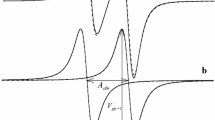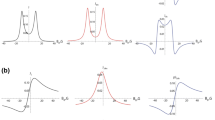Abstract
Manifestations of the spin coherence transfer induced by the exchange and dipole–dipole interactions between spin probes in dilute solutions in the electron paramagnetic resonance (EPR) spectra have been studied. The perturbation theory of manifestations of the spin coherence transfer in the EPR spectra of nitroxide free radicals elaborated by one of the authors Salikhov (Applied Magnetic Resonance 38:237–256, 2010) has been generalized with allowance for the super hyperfine structure of the EPR spectra. For 14N nitroxide radicals, the total EPR spectrum was presented as a sum of three independent components in the case of slow and intermediate spin coherence transfer rates. The shapes of these components were found. The side components of the EPR spectrum contain the absorption and dispersion contributions and, as a result, have the asymmetric (mixed) shapes. These asymmetric components can be presented as J = J absorption ± p J dispersion. The p value is found for the arbitrary super hyperfine structure of the spectrum. In the slow and intermediate spin coherence transfer rate regime, the parameter p is independent of the super hyperfine interactions in the nitroxide radicals, but the shapes of J absorption and J dispersion terms depend on the super hyperfine structure of the nitrogen components of the nitroxide EPR spectrum and on the spin coherence transfer rate. It is confirmed theoretically that a good strategy to evaluate the spin coherence transfer rate from the EPR spectra is using the dispersion contribution to the shape of the EPR spectra of nitroxide free radicals. An algorithm is suggested and tested for determining the spin coherence transfer and spin decoherence rates.










Similar content being viewed by others
References
K.M. Salikhov, Appl. Magn. Reson. 38, 237–256 (2010)
B.L. Bales, M. Peric, J. Phys. Chem. B 101, 8707–8716 (1997)
B. L. Bales, M. Peric, J. Phys. Chem. A 106, 4846–4854 (2002)
K.I. Zamaraev, Yu.N. Molin, K.M. Salikhov, Spin Exchange (Nauka, Siberian Branch, Novosibirsk, 1977). (in Russian)
Yu.N. Molin, K.M. Salikhov, K.I. Zamaraev, Spin Exchange. Principles and Applications in Chemistry and Biology (Springer, Berlin, Heidelberg, New York, 1980)
B.L. Bales, in Biological Magnetic Resonance, vol. 8, ed. by L.J. Berliner, J. Reuben (Plenum Publishing Corporation, N.Y., 1989), pp. 77–130
A. Abragam, Nuclear Magnetism. Principles of Nuclear Magnetism (Oxford University Press, London, 1961)
K.M. Salikhov, A.G. Semenov, Yu.D. Tsvetkov, Electron Spin Echo (Nauka, Siberian Branch, Novosibirsk, 1976). (in Russian)
R.T. Galeev, K.M. Salikhov, Khim. Fiz. 15, 48–64 (1996) (in Russian)
B.L. Bales, D. Willett, J. Chem. Phys. 80, 2997–3004 (1984)
J.H. Freed, G.K. Fraenkel, J. Chem. Phys. 39, 326–348 (1963)
J.D. Currin, Phys. Rev. 126, 1996–2001 (1962)
K.M. Salikhov, J. Magn. Reson. 63, 271–279 (1985)
Acknowledgments
We are grateful to Prof. Barney L. Bales for numerous discussions. We thank Dr. L. V. Mosina for language editing of the manuscript. This work was financially supported by the President grant for leading scientific schools of Russian Federation, by the grant for the fundamental research of the Presidium of the Russian Academy of Sciences.
Author information
Authors and Affiliations
Corresponding author
Appendix
Appendix
1.1 Perturbation Theory of the EPR Spectrum Shape of 14N Nitroxide Radicals
We consider the solution of the 14N nitroxide radicals. The hyperfine interaction with nitrogen nuclei in nitroxides is much larger than the super hyperfine interaction with other magnetic nuclei. In this case at the low radical concentration (C → 0), the expected EPR spectrum is shown schematically in Fig. 1. There are three bands which correspond to the projections of the nitrogen nuclear spins, m = +1, 0, −1. Each of these bands has an additional super hyperfine structure due to the interaction of unpaired electrons with other (except for nitrogen) magnetic nuclei (protons, deuterons, 13C). The widths of these bands ∆Ω 0 (see Fig. 1) are less than the distances between centers of these bands, ∆Ω 0 < a N. The spin coherence transfer terms V kn in Eqs. (1, 7) connect magnetizations of the subensemble of nitroxides with different resonance frequencies. In the wide range of the radical concentrations, the transition terms V kn can be much less than the nitrogen hyperfine splitting, (1/3) K ex C < a N. In this case, the spin coherence transfer between spins which belong to different nitrogen EPR spectrum bands can be treated in the framework of the perturbation theory for non-degenerate resonance frequencies. Under the same condition, the spin exchange inside nitrogen components of the EPR spectrum corresponds to the quasi-degenerate case.
The EPR spectrum shape is found from the solution of the system of Eq. (7) in the rotating frame for the partial transverse magnetizations M k :
where W = K ex C + 1/T 2dd, V = K ex C − 1/T′2dd.
We divide all subensembles of nitroxide radicals into three groups which correspond to three projections of the 14N nuclear spins, m = 1, 0, −1, while a set of numbers {n} characterizes all super hyperfine structure components in each nitrogen component of the EPR spectrum (see Fig. 1). Then, in Eq. (19), k ≡ {m, n}, M k ≡ M mn = {M 1n , M 0n , M −1n }, g k ≡ g m g n = (1/3)g n . In these notations, we rewrite Eq. (19) as:
In these equations, the terms marked in bold italic describe the spin exchange between spins with sufficiently large difference of their resonance frequencies. Their contributions to the solution of Eq. (20) can be found using the perturbation theory for the non-degenerate case. In the approximation, linear over V the partial magnetizations M 1n , M0n , and M −1n and the right-hand sides of Eq. (20) take the form:
The right-hand side of Eq. (20) is transformed analogously:
Due to the spin coherence transfer between different nitrogen components, the resonance frequencies shift as:
In Eqs. (21–23), the denominators of 1/(ω mn − ω pq ) are the difference of the resonance frequencies of spins, which belong to different nitrogen components of the EPR spectrum. We assume that the difference (ω mn − ω pq ) is mainly determined by the hyperfine interaction with nitrogen: (ω 1n − ω 0q ) ≅ a N, (ω 0n − ω −1q ) ≅ a N, (ω 1n − ω −1q ) ≅ 2 a N. With this approximation, Eqs. (21–23) take the forms:
Thus, for the small parameter (1/3) V/a N < 1, Eq. (20) takes the form of the uncoupled equations for the transverse magnetizations of the nitrogen hyperfine components:
where M*1 = Σ M*1n , M*0 = Σ M*0n , M*−1 = Σ M*−1n .
These equations give:
The magnetizations M*1, M*0, and M*−1 can be found straightforwardly:
where
In the EPR experiments, one observes the total transverse magnetization M = M 1 + M 0 + M −1. In the approximation, linear over V/a N [see Eqs. (21, 24)]
Thus, the EPR spectrum is given:
Rights and permissions
About this article
Cite this article
Salikhov, K.M., Bakirov, M.M. & Galeev, R.T. Detailed Analysis of Manifestations of the Spin Coherence Transfer in EPR Spectra of 14N Nitroxide Free Radicals in Non-Viscous Liquids. Appl Magn Reson 47, 1095–1122 (2016). https://doi.org/10.1007/s00723-016-0818-0
Received:
Revised:
Published:
Issue Date:
DOI: https://doi.org/10.1007/s00723-016-0818-0




